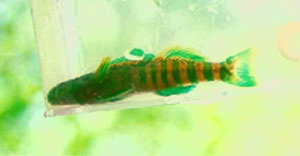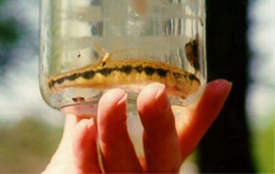Native Fish and Streamlife Observation Outing, May 11th, 2002
The North
American Native Fishes Association
Cleveland Aquarium Society
Mahoning River Consortium
by Rob Carrillio
![]()
Eagle Creek
For our first stop everyone met at Eagle Creek, which is a Mahoning River Tributary and part of The Ohio River Drainage. Our location placed us between Southington and Newton Falls, Ohio. After introducing myself and going over preliminary rules of stream etiquette " with the group, we split up in three pods to survey at least 150 yards of the stream for fish and other aquatic life. Eagle Creek, as always, greets visitors with plenty of densely shaded streamside forests, keeping water temperatures cooler than most streams I visit in the area, where some areas of the stream allow for penetration of more sunlight. Since the weather forecast was calling for a rather cool and partly cloudy day, most of us brought some kind of jacket or extra t-shirts.
I want to point out that the mosquitoes of Eagle Creek don't care what the temperature is, because they will be there waiting for blood, and as usually is the case. Those venturing into the stream became a nice tall drink of red wine for these aggressive little guys! I'm glad I didn't forget the organic repellent! I'd rather smell like a life-size citronella candle than to walk away donating half of my blood to the local mosquito blood drive!
Once we were mosquito proof, it was time to become waterproof! With waders on, cameras and nets in hand, we made our way into the steadily flowing waters of the small river. I was hoping that we would find some calm pools in the stream where we would witness some amazing breeding behavior and colors of Common Shiners and Central Stonerollers. This was not to be the situation, however, because recent rains swelled the local waterways, and most of the existing calm pool habitats simply became part of the higher water "run" habitat which was Eagle Creek this day! I volunteered to keep an inventory of the species found, so as the three groups began netting the waters, I did my best to see what each catch yielded!
Because of the rather turbid and somewhat less than clear waters, some of the color patterns and markings on the fishes became washed out. This was not to hold true with the greenside darters, however, as they were as visually dazzling as ever, displaying bright sparkling emerald green fins, deep brown mottled markings, and even some deep blues along the length of the body! It looked to me as though an expert pen and ink artist delicately sketched in the patterns on this little animal! As I assisted in holding up the viewing container in which the fish were placed, it was satisfying to see the amazement on the faces of those who have never witnessed anything like this so close to home!
What's more, when Nick Zarlinga (NANFA member and Aquatic Biologist-Cleveland MetroParks Zoo), explained to the group some of the physical make up and behavior of such fishes (Nick refers to fish behavior as "Fishanalities" "), many thought this in itself was intriguing. Few would realize, unless it was explained to them, that a darter's body is suited perfectly for the fast moving and riffle habitat where these fish prefer to reside. Add to this, who would take notice of the design of its mouth as a determining factor as to what it likes to eat!
After a few photographs, and more admiration, the darter was gently released. Other findings in the catches included the odd-looking grass pickerel, mottled sculpin, and a very large blackside darter. Eagle Creek is a haven for blacksides!
After approximately an hour and a half of netting fish and realizing what was in Eagle Creek, we made our way back to our vehicles to regroup for the next site--Rock Creek near Rock Creek, Ohio, of course! By the way, the species tally this day for Eagle Creek was 15. Since the water was high and many habitats washed out, this wasn't too bad!
to rock creeRock
Creek ![]()
Sponsored by Jonah's Aquarium
Native Fishes delivered to your door
Home of the Perfect Dipnet
Aquarium and Pond Supplies

